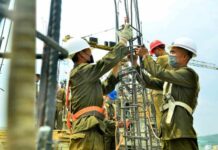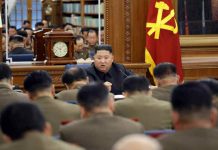Four days after the explosion which sank the Cheonan, rescue efforts and the investigation into the causes of the accident continue. In addition to attempts to find the remaining soldiers known to be trapped in the hull of the vessel, the South Korean government has begun to look into the causes of the explosion.
Contrary to the government’s initial assessment, it was not because of a hole in the ship’s stern but rather because the body of the ship broke in two that the Cheonan sank. The direction in which the steel plates bent as a result of the explosion is a clue as to the primary cause of the explosion, but many of the steel plates were destroyed in the blast.
The South Korean government was at first extremely cautious when referring to the possibility that North Korea was involved in the sinking of the Cheonan. But as Defense Minister Kim Tae Young stated yesterday, we cannot entirely exclude that possibility and must concentrate our efforts on finding the root cause.
This tentative change to the government’s official stance can be seen as an acknowledgement that it is unlikely the explosion came from within the ship. This is especially true when we consider how powerful the explosion would have to have been in order to break such an enormous (1,200 Ton) vessel in two, as well as the fact that those injured suffered virtually no burns.
Meanwhile, if the explosion was caused by an external attack, it is unlikely to have been from a torpedo, for the ship was in waters between 25 and 40 meters deep at the time. It has thus been proposed that a naval mine caused the explosion. It has been suggested that a mine could have been placed by a semi-submersible craft that went undetected by radar. In fact there are now unconfirmed intelligence reports which assert that on the day of the explosion, one such submarine was spotted maneuvering on the North Korean side of the Northern Limit Line (NLL), but that it disappeared soon thereafter.
Focusing on the idea that a mine caused the sinking, the possibility of it having been either a floating mine or an influence mine is being discussed. The former would have been dispatched directly by North Korea, whereas the latter would have been installed on the ocean floor and responded to an enemy ship entering its magnetic field.
North Korea is known to have set nearly 4000 floating mines in the East Sea. But when asked whether one such floating mine could have caused the Cheonan explosion, the South Korean Defense Minister responded, “That is impossible, for all such mines have been removed by the South Korean navy.”
It is difficult to draw any conclusion about the cause of the explosion at this stage in the investigation, but, given the present circumstances, military officials say there is a real possibility it could have been the result of provocation from the North.
A professor at Korea National Defense University, Kim Yon Su told The Daily NK in a phone interview today, “It is important to recognize that the Cheonan explosion was an incident that occurred in the vicinity of the NLL, on a patrol ship that was conducting military operations,” stressing that all possible explanations should be considered.
Kim also pointed out that although North Korea ceased criticizing the Lee Myung Bak administration last August, the disparaging remarks have recently resumed. Further, Kim believes that such a possibility becomes more likely when considering the threat issued by a representative of the Korean People’s Army general staff on the 26th to “attack using all available means.”
Assuming that North Korea was somehow involved in the explosion, Professor Kim added also that “unrest in North Korea is at its peak, so the attack may have been an effort to quell disturbances.
“It is also possible that North Korea, which has been defeated by our own navy several times, attacked us in order to boost morale and spread propaganda,” Kim also said, noting that such an intention reflects North Korea’s concern over social unrest, the growing conflict in South Korea between pro-Kim Jong Il and anti-Kim Jong Il groups, and security problems on the Korean peninsula.
Finally, Kim further pointed out that a North Korean attack could have been an effort to change the stance of China, which, despite having promised an astronomical amount of economic aid, is dispensing it on a conditional basis. North Korea knows that neighboring countries want a stable environment for the upcoming Shanghai World Expo and Asian Games, and could be taking advantage of the situation to secure more aid.
However, an anonymous North Korean expert took a more cautious approach, saying, “Although there is the possibility that North Korea is exacting revenge for the naval battle defeat last November, it is still too early to presume that North Korea was involved in the explosion.
The same analyst further pointed out that it is currently too difficult for the government to focus on any issue other than the rescue mission, and that drawing conclusions about North Korea’s implication in the matter could bring about its own crisis.
Yet he still has confidence the South Korean government will be able to soon release findings that are acceptable to the public. “Our surveillance of the North Korean army as well as intelligence gathering skills have gotten better in comparison to the past.”
However, rescue efforts have been stymied by a lack of time and poor weather conditions, so investigating the details of the cause of the explosion will require more time. Even members of the South Korean navy’s Ship Salvage Unit (SSU), which was dispatched to the area of the explosion, and eye witnesses to the tragedy would find it difficult to draw any conclusions based on the direction of the steel plates.
There still remains the chance that the cause of the Cheonan explosion will be uncovered through the ship’s recovery and thorough, expert investigation. But to attribute any physical evidence to North Korea, we would have to find fragments of a North Korean mine or torpedo, another difficult task.
One anonymous expert did point out, though, “The United States is demonstrating great interest in this incident,” and “If the U.S. were to help in investigating the cause of the explosion, there would be few difficulties in terms of verification.”
If the explosion were found to be the fault of North Korea, South Korea, the U.S. and Japan would lead the way in strengthening current sanctions, and it is very likely the government would switch to a more aggressive North Korea policy.
The South Korean military will for sure respond to the situation, although exactly what measures it will pursue is uncertain. Depending on the situation, it seems inevitable that tensions will rise sharply, possibly even leading to a suspension of North-South contact.




















